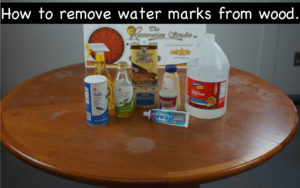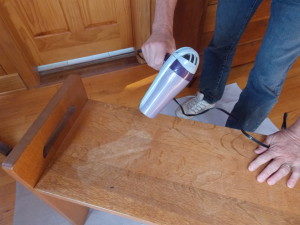DIY Methods To Remove Water Stains From Wood Furniture
White Heat and water marks Can Be Very Upsetting And Unsightly When They Show Up On Your Furniture.
Discover the DIY methods used to Remove Water Stains From Wood Furniture

A quick search on the internet will uncover dozens of "miracle methods" to remove water stains from wood furniture. It's easy, right? BUT WAIT......before we put that hot iron to work on our expensive furniture, there are a few things we should know.
In this Tutorial, we'll go over many methods to remove these white water stains. Most importantly, we'll discuss why some might work, and some might not depending on the finish involved.
|
Before attempting to remove water stains from wood furniture, its essential to know exactly what the finish is on your furniture. You can do spot tests in an inconspicuous area like the underside of an apron, table top, or leg. If the finish dissolves easily in lacquer thinner, you're dealing with lacquer. If it dissolves in denatured alcohol, its most likely shellac. And if it doesn't dissolve in either, its probably a varnish of some kind.
Lacquer Finish
Lacquer itself has been used commercially on furniture since the 1920's, so lets keep in mind that a lacquer finish from lets say 1940, is a completely different animal than a lacquer finish from 2010.
As a rule of thumb, the older the finish, the easier it should be to remove water stains from wood furnitute.
Shellac and oil Finish
Many antiques were finished with shellac, even after the introduction of lacquer. Oil was used on a lot of woods such as teak or rosewood, as well as others and it was very highly used on danish style furnishings.
Understanding what causes these white blotches and rings
Both water and heat can cause white blotches and rings on wood finishes. These milky white marks caused by moisture getting into the finish and creating voids, thus interfering with the finish’s transparency.
To remove milky-white water marks, you need to consolidate or re-amalgamate the finish (eliminate the voids) to the point that the transparency is reestablished. Success is not predictable, but in general, a white water ring is easier to remove in the following circumstances: 1) the finish is older or in poor condition, 2) the shorter the time the water mark has been in the finish, and 3) the shallower the damage goes into the finish.
Okay, So where do we start?
To remove water stains from wood furniture, It's always a good idea to start with the least invasive methods first, and work your way towards the more aggressive (and potentially damaging) methods.

Remove Water Stains From Wood
In the video to the right, I do just that, and demonstrate each product and procedure as I work through them. I will add, that being a refinisher for the past 30 years I knew which products would work, and which wouldn't on this finish. So while some of these methods didn't remove the water stains on this table......they may on yours!!!
"How To Video"
Testing many of the home remedy fixes to Remove Water Stains From Wood furniture that we found by searching the internet.
Our test subject is a modern lacquer dining table.
What We Learned In The Video
The finish on the subject table was a modern version of lacquer, as the table was made in the 21st century. It's unlikely that it was a catalyzed lacquer, due to the severity of the white water and heat marks. Typically on a modern lacquer finish, most home remedies won't work.
We did show you a method to Remove Water Stains From Wood furniture that worked exceptionally well and in the end we were able to remove almost all of the white haze on a very difficult test subject.
Keep in mind, that while some of these methods didn't work to Remove Water Stains From Wood on the test finish, they will work on some - perhaps yours. Therefor, it's important that you give them a try before moving to harsher methods such as the one used to repair the piece of furniture in the video.
Understanding Why Some Of These Home Remedies Work To Remove Water Stains From Wood
By applying an oily substance, such as olive oil, petroleum jelly or mayonnaise to the damaged area and allowing the liquid or gel to remain overnight will oftentimes restore some of the transparency by filling some of the microscopic voids. The thing is, the finish must be porous enough to allow the oil or gel to penetrate.

When oil penetration is allowable, some of these methods appear to work like "magic". It's actually a simple theory, and not magic at all. Scratch cover oils work through the exact same process. Typically, they either work very well, or not at all.
By adding salt, baking powder and even toothpaste, we are making the process slightly more aggressive through the form of an abrasive. This can work by modestly scouring the surface of the finish, allowing for penetration to the voids.
Fighting Fire With Fire
The use of heat to remove heat marks of wood furniture
Heat the finish with a blow dryer, heat gun or iron to soften the finish so it consolidates.
This may restore some of the transparency if you get the temperature just right , especially on modern film finishes that are unaffected by the above techniques. However, PROCEED WITH CAUTION - if you get the finish too hot, it will blister the finish on your furniture. Once the finish is blistered or burned, it is irreversible and will require refinishing. Avoid getting the finish any hotter than is comfortable to touch.
*When Using Heat - Please Proceed With Caution
Remember, heat is also a technique used to remove finish and veneer.
Enough said.....

Set the hair dryer on medium heat and hold it three to six inches away from the white heat stain to begin with. As you apply heat to the furniture, use a soft cotton cloth to buff away the mark. Be sure not to get too close and blister the finish. The process can take from five to twenty minutes. Continue wiping until the surface is blemish-free.
Using an iron to remove heat and water rings on furniture

- Turn your iron on, adjusting its heat setting to medium. Turn off the iron's steam switch, if applicable, to ensure that the iron remains dry. Wait for several minutes to allow the iron to heat up completely.
- Place a clean, dry cotton cloth over the water ring on the wood furniture surface. Set the iron down on top of the cloth, centering it over the ring stain. Press the iron down and begin moving the iron in circular motions. I always suggest to keep the iron moving. Within 3-5 seconds, remove the iron.
- Remove the iron from the piece of furniture and lift the cloth from the surface. Check the surface to see if the white ring remains visible. Replace the cloth and reapply the iron in the same manner to the furniture as before. Repeat this process as needed until the white heat or water stain disappears.
Re-Amalgamating A Furniture Finish
*Amalgamation is the process of combining two or more things into one form. Re-amalgamating a furniture finish is the process of returning a finish that has separated due to heat or moisture into a unified finish
IN THE VIDEO ABOVE, Rod shows us a gentile form of amalgamating lacquer to remove white water and heat stains using Lacquer thinner and Howard Restor A Finish.
The process is the same for re-amalgamating shellac and lacquer, with the only difference being the solvent used. For lacquer, we use lacquer thinner. For shellac, we us denatured alcohol. It’s important to work fast and concentrate on one small area at a time.
*Warning - Using heat or solvents on your furniture "can" cause severe damage to the finish - and even to the wood itself. Test on inconspicuous areas first and proceed with caution.
As a rule, we advise against using an Iron or re-amalgamation unless you are prepared to refinish as you last resort. Both processes "can" work in removing white moisture blotches, but both processes can also make your situation worse resulting in the need to refinish. Results will vary and are unpredictable.

